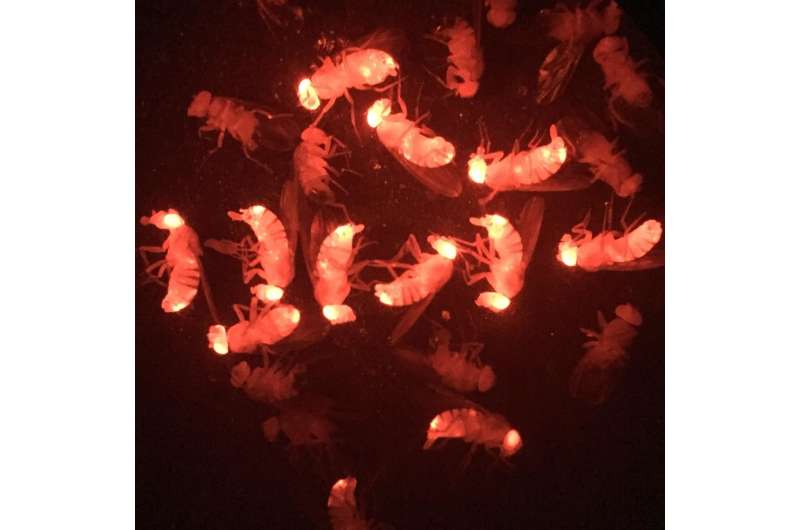Fruit flies with a CRISPR gene drive carrying a red fluorescent protein as payload. Credit: Jackson Champer
A study in fruit flies suggests that existing approaches to gene drives using CRISPR/Cas9, which aim to spread new genes within a natural population, will be derailed by the development of mutations that give resistance to the drive. Jackson Champer, Philipp W. Messer, and colleagues at Cornell University in Ithaca, New York report these findings July 20, 2017 in PLOS Genetics.
Gene drives offer tremendous hope for preventing the spread of mosquito-borne diseases and controlling invasive species. Newly developed approaches that use CRISPR/Cas9 gene editing technology can generate offspring that carry copies of the altered gene on both chromosomes - a phenomenon called super-Mendelian inheritance that, in theory, should quickly convert an entire population. This process, however, can also create resistant genetic sequences and organisms that cannot be converted. In the current study, researchers tested two different CRISPR gene drive constructs in the model fruit fly, Drosophila melanogaster, to investigate the rise of resistance. They saw that resistant gene variations formed frequently, both before fertilization in the germline and within the embryo. Further analysis showed that in insects with genetically diverse backgrounds, as found in wild populations, there was considerable variation in terms of how efficiently the offspring converted, and how often resistance genes arose.
The study demonstrates that the evolution of resistance will likely be a severe roadblock for existing CRISPR gene drive approaches, which must be addressed before scientists could successfully employ them in the wild. In the coming years, research groups have planned gene drives in mice on islands off the coast of Massachusetts to prevent the spread of Lyme disease, and in tree snakes in Guam to control these invasive species. New gene drive approaches will be necessary to overcome the challenge posed by resistance, especially in genetically diverse, natural populations.
James J. Bull and Harmit S. Malik further discuss the research in an accompanying Perspective entitled "The Gene Drive Bubble: new realities", also published July 20th, 2017 in conjunction with this primary Research Article.
More information: Champer J, Reeves R, Oh SY, Liu C, Liu J, Clark AG, et al. (2017) Novel CRISPR/Cas9 gene drive constructs reveal insights into mechanisms of resistance allele formation and drive efficiency in genetically diverse populations. PLoS Genet 13(7): e1006796. doi.org/10.1371/journal.pgen.1006796
Bull JJ, Malik HS (2017) The gene drive bubble: New realities. PLoS Genet 13(7): e1006850. doi.org/10.1371/journal.pgen.1006850
Journal information: PLoS Genetics
Provided by Public Library of Science
























